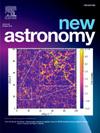变色龙I星协中恒星的光曲线
IF 2.1
4区 物理与天体物理
Q2 ASTRONOMY & ASTROPHYSICS
引用次数: 0
摘要
恒星形成区域对于研究各种质量的非常年轻的恒星物体是必不可少的。它们仍然含有大量的尘埃和气体。本文对变色龙1星群的恒星光曲线进行了研究。我们利用MKCLASS的自动光谱分类,利用NEOWISE和Gaia巡天的光曲线来识别野外恒星的光谱类型。利用Peranso软件和astropy对光曲线进行了分析。我们还使用VSX来识别可变性类型。根据天体测量学,我们已经确定了92颗恒星,其中73颗是该协会的成员。我们收到了盖亚巡天中55颗恒星和ALLWISE/NEOWISE巡天中69颗恒星的光线曲线。其中28个可以确定变量的类型,主要是金牛座和猎户座的变量。这些成员的光谱类型大多是温度较低的m型恒星,其中一颗可能是化学特殊(CP)恒星。与光曲线测量相关的非成员包括光谱类型A-G和一个CP候选。本文章由计算机程序翻译,如有差异,请以英文原文为准。
Lightcurves of stars in the Chamaeleon I association
Star-forming regions are essential for studying very young stellar objects of various masses. They still contain a significant amount of dust and gas. We present a study of light curves of stars in the field of the Chamaeleon I association. We use automatic spectral classification with MKCLASS to identify the spectral types of the stars in the field with a light curve from the NEOWISE and Gaia surveys. The light curves are analysed using the software Peranso and astropy. We also used VSX to identify the variability type. Based on astrometry, we have identified 92 stars, 73 of which are members of the association. We received light curves for 55 stars from the Gaia survey and for 69 stars from the ALLWISE/NEOWISE survey. For 28 of them, it was possible to determine the types of variables, mostly T Tauri and Orion variables. The spectral types of the members are mostly cooler M-type stars, with one being a possible chemically peculiar (CP) star. The non-members associated with light curve measurements include spectral types A-G with one CP candidate.
求助全文
通过发布文献求助,成功后即可免费获取论文全文。
去求助
来源期刊

New Astronomy
地学天文-天文与天体物理
CiteScore
4.00
自引率
10.00%
发文量
109
审稿时长
13.6 weeks
期刊介绍:
New Astronomy publishes articles in all fields of astronomy and astrophysics, with a particular focus on computational astronomy: mathematical and astronomy techniques and methodology, simulations, modelling and numerical results and computational techniques in instrumentation.
New Astronomy includes full length research articles and review articles. The journal covers solar, stellar, galactic and extragalactic astronomy and astrophysics. It reports on original research in all wavelength bands, ranging from radio to gamma-ray.
 求助内容:
求助内容: 应助结果提醒方式:
应助结果提醒方式:


